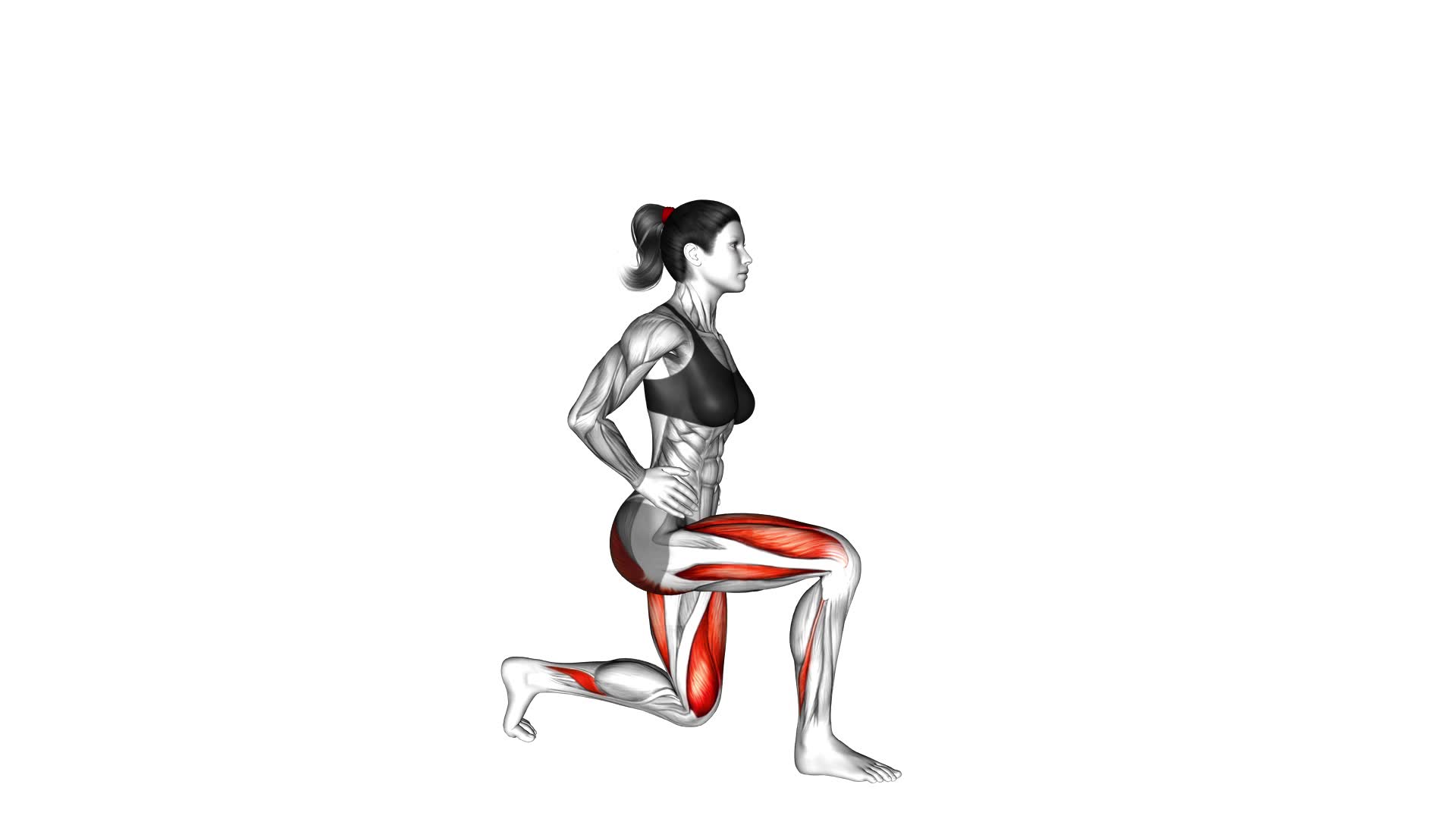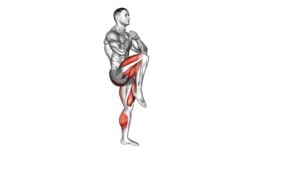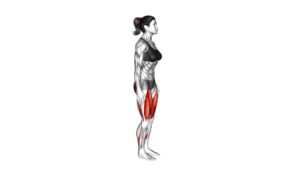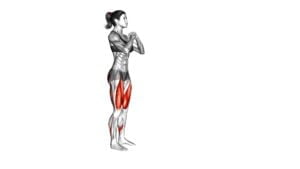Lunge (female) – Video Exercise Guide & Tips

Get ready to take your lunges to the next level! In this video exercise guide, we'll show you the proper form and technique for lunges, specifically designed for women.
Watch This Exercise Video
Discover the amazing benefits of lunges for your fitness journey and learn variations and modifications for all fitness levels.
Avoid common mistakes and get expert tips for increasing intensity and getting the best results.
Get ready to lunge your way to a stronger, healthier you!
Key Takeaways
- Proper form and technique are important to protect joints and reduce the risk of injury during lunges.
- Lunges target multiple muscle groups in the lower body, improve strength and flexibility, and help tone and sculpt the lower body.
- There are different lunge variations and modifications for all fitness levels, allowing for variety and customization in workouts.
- Increasing intensity and results can be achieved by incorporating resistance, trying advanced lunge variations, and maintaining proper form and engagement of the core.
Proper Form and Technique
To perform a lunge correctly, you need to focus on maintaining proper form and technique. Lunge variations can be beneficial for targeting different muscles and adding variety to your workout routine.
The benefits of proper form during lunges are numerous. Firstly, maintaining proper alignment helps to protect your joints and reduce the risk of injury. By keeping your knee in line with your ankle and not letting it go past your toes, you can prevent unnecessary strain on your knee joint.
Secondly, proper form ensures that you're effectively targeting the muscles you intend to work. By engaging your glutes, quadriceps, and hamstrings, you can maximize the benefits of the lunge exercise.
Additionally, maintaining a stable core and an upright posture during lunges helps to improve your balance and stability. This is especially important if you're performing lunge variations that require more coordination, such as walking lunges or jumping lunges.
Benefits of Lunges for Women
By incorporating lunges into your workout routine, you can experience a range of benefits that specifically cater to women's fitness goals. Lunges are incredibly important for women's fitness because they target multiple muscle groups in the lower body, including the glutes, hamstrings, quadriceps, and calves. This exercise helps to improve lower body strength and flexibility in women, making it an excellent addition to any fitness program.
One of the key benefits of lunges for women is that they can help to increase lower body strength. As you lunge forward and lower your body, your muscles are engaged to support your body weight. This constant resistance helps to build strength in your legs, which can be particularly beneficial for women who want to tone and sculpt their lower body.
In addition to building strength, lunges also improve flexibility in the lower body. When performing a lunge, you're required to stretch and lengthen the muscles in your legs, which can help to improve your overall range of motion. This increased flexibility can be particularly advantageous for women who participate in activities that require a greater range of motion, such as dance or yoga.
Variations and Modifications for All Fitness Levels
Try different variations and modifications of lunges to cater to your fitness level and achieve optimal results. If you have an injury or are recovering from one, it's important to modify the lunge exercise to avoid further strain. One modification you can try is the stationary lunge, where you keep one foot in place and step forward with the other foot, bending your knees and lowering your body. This reduces the strain on your joints while still engaging your leg muscles.
For beginners, it's advisable to start with easier variations of lunges. One option is the reverse lunge, where you step backward instead of forward. This variation helps to improve balance and stability, making it a great choice for those who are new to lunges. Another beginner-friendly variation is the side lunge, where you step to the side instead of forward. This works your inner and outer thigh muscles, helping to tone and strengthen them.
Remember, when performing lunges, it's important to maintain proper form and alignment. Keep your chest lifted, shoulders relaxed, and core engaged. Take it slow and listen to your body. If you experience any pain or discomfort, modify the exercise or consult a fitness professional for guidance.
With consistency and the right modifications, lunges can be a highly effective exercise for all fitness levels.
Common Mistakes to Avoid During Lunges
Avoid these common mistakes when performing lunges to ensure proper form and maximize the effectiveness of your workout.
Maintaining the correct lunge form is crucial to avoid injuries and to target the right muscles.
One common mistake is allowing the front knee to extend past the toes. This not only puts unnecessary strain on the knee joint but also reduces the activation of the glutes and hamstrings. To fix this, focus on keeping the front knee directly above the ankle throughout the movement.
Another mistake to avoid is rushing through the lunge. By not fully extending the legs or pausing at the bottom of the movement, you're missing out on the full benefits of the exercise. Take your time and make sure to complete a full range of motion.
Lastly, neglecting to engage the core during lunges can lead to poor balance and stability. Remember to keep your core tight and maintain an upright posture throughout the exercise.
By avoiding these common mistakes and ensuring proper form, you can make the most out of your lunges and achieve better results.
Don't forget that there are various lunge modifications available to suit different fitness levels and goals.
Tips for Increasing Intensity and Results
To maximize the intensity and results of your lunges, consider incorporating these tips and techniques:
- Increase Resistance:
- Incorporate weights: Hold dumbbells in each hand or wear a weighted vest to add resistance and challenge your muscles.
- Use resistance bands: Attach resistance bands to your ankles or hips to increase the difficulty of the exercise and engage your muscles further.
- Try Advanced Lunge Variations:
- Reverse lunges: Instead of stepping forward, step backward into the lunge position. This variation targets your glutes and hamstrings more effectively.
- Walking lunges: Take lunges forward, alternating legs with each step. This variation increases the cardiovascular demand and adds a dynamic element to your workout.
By increasing resistance and incorporating advanced lunge variations, you can take your lunges to the next level and achieve better results. These techniques challenge your muscles in different ways, promoting strength and muscle growth. Remember to maintain proper form and engage your core throughout the exercise for maximum effectiveness.
Now that you have learned how to increase the intensity of your lunges, let's move on to the next section where we'll provide you with a sample lunge workout routine to help you incorporate these tips into your fitness regimen.
Sample Lunge Workout Routine
To incorporate the tips and techniques mentioned in the previous section and maximize the intensity of your lunges, follow this sample lunge workout routine.
Start with a dynamic warm-up to prepare your body for the workout. Perform 10-15 minutes of light cardio exercises such as jogging or jumping jacks.
For the main workout, begin with basic lunges. Stand with your feet hip-width apart and take a step forward with your right foot, bending both knees to lower your body. Push through your right heel to return to the starting position. Repeat on the other side. Aim for 3 sets of 12-15 reps on each leg.
Next, incorporate lunge variations to target different muscle groups. Try reverse lunges, where you step backward instead of forward, or lateral lunges, where you step to the side. These variations challenge your muscles in new ways, enhancing the effectiveness of your workout.
To further increase the intensity, consider adding lunge equipment. You can hold dumbbells in your hands or wear ankle weights to add resistance. This will help to strengthen and tone your muscles even more.
Finish your workout with a cool-down, including static stretches for your legs and hips. This will help to prevent muscle soreness and improve flexibility.
Remember to listen to your body and adjust the workout to your fitness level. With consistency and proper form, this sample lunge workout routine can help you achieve your fitness goals.
Frequently Asked Questions
How Many Sets and Reps Should I Do for Lunges to See Results?
To see results from lunges, you should aim to do 2-3 sets of 10-12 reps.
Lunges are great for weight loss as they engage multiple muscle groups and help to build strength and endurance.
By incorporating lunges into your workout routine, you can improve your balance, flexibility, and overall lower body strength.
Remember to maintain proper form and gradually increase the intensity of your lunges to continue seeing progress.
Can Lunges Help Improve My Balance and Stability?
Lunges are a great exercise for improving your balance and stability. By incorporating lunges into your workout routine, you can enhance your coordination and strengthen your core. This exercise targets multiple muscle groups, including your quads, glutes, and hamstrings, which helps to improve overall stability.
Additionally, lunges require you to engage your core muscles for stability, further enhancing your balance. So, if you're looking to improve your balance and stability, lunges are definitely worth incorporating into your fitness routine.
Should I Use Weights While Performing Lunges?
Using weights while performing lunges can provide additional resistance and enhance the benefits of this exercise. Adding weights challenges your muscles, increasing strength and toning. The added resistance also helps improve your stability and balance, as your muscles have to work harder to maintain control.
However, it's important to start with lighter weights and gradually increase as you become more comfortable and confident. Consult a fitness professional to ensure proper form and technique to avoid injury.
Are There Any Precautions or Modifications I Should Consider if I Have Knee Pain?
To prevent knee injuries during lunges, there are a few precautions and modifications you should consider.
First, make sure to maintain proper form by keeping your knee aligned with your ankle and not letting it go past your toes.
Additionally, you can try alternative lunge variations that put less stress on the knees, such as reverse lunges or side lunges.
Remember to listen to your body and stop if you feel any pain or discomfort.
Can Lunges Help With Toning and Shaping the Glutes?
Lunges are an effective exercise for toning and shaping the glutes. To target your glutes, focus on the best lunge variations, such as walking lunges, reverse lunges, or curtsy lunges.
Incorporating lunges into a full body workout routine is a great way to engage multiple muscle groups and boost overall strength. By including lunges in your workout, you can achieve the toned and shaped glutes you desire.
Conclusion
In conclusion, lunges are a highly effective exercise for women that can be modified to suit all fitness levels. By maintaining proper form and technique, women can reap the numerous benefits of lunges, such as increased leg strength and improved balance.
It's important to avoid common mistakes and gradually increase intensity for optimal results. Incorporating lunges into a well-rounded workout routine can help women achieve their fitness goals and enhance overall lower body strength.

Author
Years ago, the spark of my life’s passion ignited in my mind the moment I stepped into the local gym for the first time. The inaugural bead of perspiration, the initial endeavor, the very first surge of endorphins, and a sense of pride that washed over me post-workout marked the beginning of my deep-seated interest in strength sports, fitness, and sports nutrition. This very curiosity blossomed rapidly into a profound fascination, propelling me to earn a Master’s degree in Physical Education from the Academy of Physical Education in Krakow, followed by a Sports Manager diploma from the Jagiellonian University. My journey of growth led me to gain more specialized qualifications, such as being a certified personal trainer with a focus on sports dietetics, a lifeguard, and an instructor for wellness and corrective gymnastics. Theoretical knowledge paired seamlessly with practical experience, reinforcing my belief that the transformation of individuals under my guidance was also a reflection of my personal growth. This belief holds true even today. Each day, I strive to push the boundaries and explore new realms. These realms gently elevate me to greater heights. The unique combination of passion for my field and the continuous quest for growth fuels my drive to break new ground.







